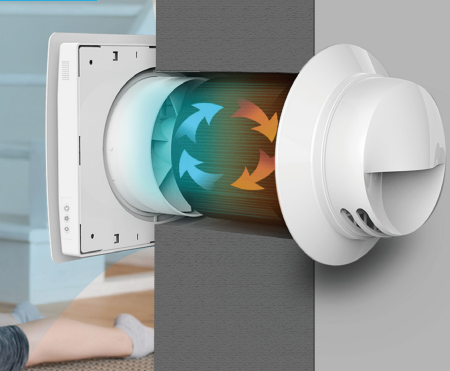Just How Heat Recovery Ventilation Enhances Indoor Air High Quality and Reduces Power Expenses
Heat Recovery Ventilation (HRV) systems play an important duty in enhancing interior air high quality while simultaneously reducing energy costs. By successfully trading stale indoor air with fresh exterior air, HRVs assist keep excellent humidity and lower contaminants. In addition, their capability to recoup warm from outgoing air decreases the strain on home heating and cooling down systems. As energy expenses proceed to increase, recognizing the full capacity of HRV systems comes to be increasingly crucial for homeowners and services alike.
Recognizing Heat Recovery Ventilation Systems

Heat recovery ventilation (HRV) systems play a necessary role in enhancing indoor air top quality, specifically in modern, energy-efficient buildings. These systems are created to move warmth from the outbound stagnant air to the incoming fresh air, consequently decreasing power loss while maintaining optimal temperature degrees inside. HRVs are composed of a warmth exchanger, followers, and ductwork, helping with the constant blood circulation of air. By expelling indoor pollutants and introducing fresh air, HRVs help to balance humidity levels, protect against mold and mildew development, and lower allergens. The effectiveness of HRV systems hinges on their capacity to recoup approximately 80% of the warmth from the worn down air, advertising power preservation while ensuring a healthy and balanced interior atmosphere. Their integration is important in achieving lasting living methods.
The Relevance of Indoor Air Quality
Indoor air quality (IAQ) is an essential factor influencing the health and wellness and health of occupants in any environment. Poor IAQ can result in numerous health issues, including respiratory troubles, allergic reactions, and exhaustion. In addition, it can exacerbate existing conditions such as asthma. Aspects adding to reduced IAQ consist of toxins from interior sources like cleaning representatives, mold and mildew, and insufficient air flow. Consequently, maintaining excellent IAQ is vital for promoting a risk-free and comfy living or working area. Reliable techniques to boost IAQ include regular tracking of air quality, appropriate air flow systems, and reducing making use of dangerous materials inside your home. By prioritizing IAQ, people can guarantee a healthier atmosphere that cultivates performance and overall quality of life.
Power Performance Perks of HRV Equipments
Several house owners and structure managers are increasingly recognizing the power effectiveness advantages of heat recovery air flow (HRV) systems. By moving warm from tired indoor air to inbound fresh air, HRV systems noticeably reduce the energy needed for home heating and cooling. This process decreases reliance on standard a/c systems, causing lower power bills. In addition, HRVs aid preserve a well balanced indoor climate, avoiding too much home heating or cooling down needs. The capacity to recoup as much as 90% of the warm from outbound air also sustains sustainability efforts by minimizing general power consumption. HRV systems add not only to set you back savings however also to a decreased carbon footprint, aligning with the growing emphasis on energy-efficient structure methods.
Installation and Upkeep Considerations
The reliable implementation of warm recuperation air flow (HRV) systems calls for cautious consideration of setup and maintenance variables to assure peak efficiency. Proper positioning of the HRV unit is important, as it ought to be installed in a location that maximizes air flow while decreasing sound disruption. Furthermore, ductwork needs to be properly sized and shielded to avoid power loss. Routine upkeep, consisting of filter replacement and system cleaning, is vital to protect optimum capability and indoor air quality. Owners must develop a routine maintenance timetable to recognize and deal with possible issues before they rise. news Collaboration with experienced experts during both installation and upkeep stages can improve the long life and efficiency of HRV systems, eventually leading to far better indoor settings and decreased power prices.
Real-World Applications and Success Stories
Exploring real-world applications of heat healing air flow (HRV) systems reveals their substantial influence on interior air high quality and power performance across different settings. In property structures, property owners have reported improved air quality, leading to less allergic reactions and respiratory problems. Schools carrying out HRV systems have actually noted improved trainee concentration and decreased absenteeism as Discover More Here a result of far better ventilation. Industrial structures, such as workplaces and retail rooms, have experienced lower energy costs and boosted worker productivity. A corporate workplace in a temperate environment achieved a 30% decrease in energy expenses after setting up an HRV system. These success tales demonstrate that HRV modern technology not just contributes to healthier settings but also offers tangible monetary benefits, making it a useful financial investment for numerous sectors.
Frequently Asked Questions
Can HRV Solutions Reduce Irritants in Indoor Air?
The efficiency of HRV systems in decreasing interior allergens largely depends upon their capability to filter and exchange air. HRV Heat Recovery Ventilation. By continuously changing stale air, these systems can substantially lower allergen degrees throughout interior atmospheres

Exactly How Does Humidity Affect HRV System Efficiency?
Humidity greatly affects HRV system efficiency; high levels can cause condensation, minimizing effectiveness, while reduced humidity might enhance air exchange. Stabilizing moisture is crucial for perfect procedure and keeping interior air quality.
Are HRV Systems Noisy During Operation?
HRV systems can produce varying noise degrees throughout procedure, depending upon their style and installment. Some devices run quietly, while others may produce noticeable sound, specifically at higher airflow setups or when inadequately kept.
What Is the Typical Life Expectancy of an HRV System?

Can HRV Solutions Be Utilized in All Climates?
HRV systems can be used in numerous environments, yet look at here now their efficiency may differ - HRV Heat Recovery Ventilation. In severe temperatures, adjustments or extra systems could be essential to guarantee optimal efficiency and convenience while maintaining indoor air quality